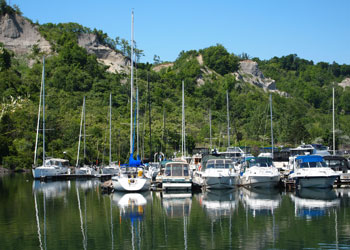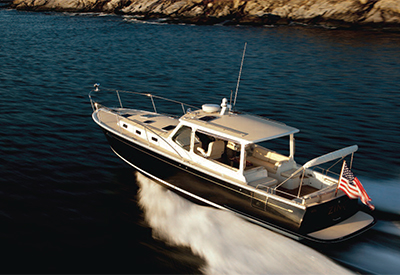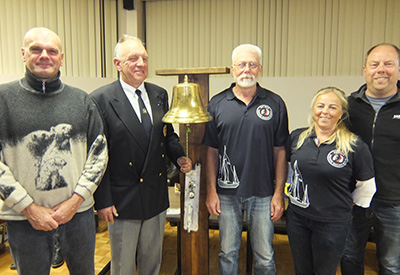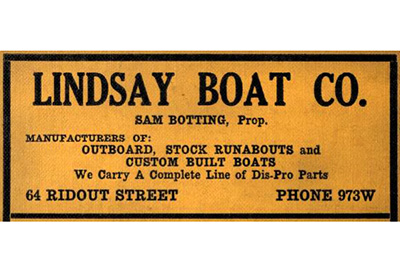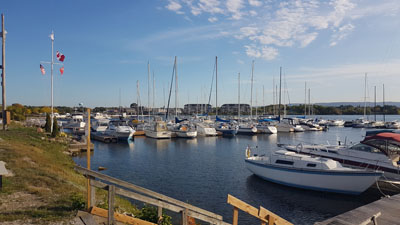Dobson Yacht Club – a History

Oct 12, 2017
Located across the harbour from downtown Sydney the Dobson Yacht Club has an interesting history.
The Dobson Yacht Club (DYC), like so many other good ideas, had a humble beginning. The year was 1953, a time of relative prosperity in Cape Breton. Sydney Steel was booming and coal was still King. It was a time of rebuilding and hard work following the war, but it was also a time when recreation was important as a diversion from the everyday realities of life.
One such diversion was Snipe racing. These small sailing vessels provided an inexpensive form of entertainment. Sydney Harbour’s only yacht club, the Royal Cape Breton was reaping the benefits of the increase in the number of Snipe racing enthusiasts. However, several members of the Royal Cape Breton’s Snipe Sailing Fleet had become disillusioned with some of the restrictive practices of that club. So, with nothing more than a dream, they began to consider starting their own yacht club.

These dreamers had absolutely no assets, but they were attracted to a piece of land directly across the harbour. A build-up of stone ballast dumped there over the years formed a crude breakwater filled in with sand and gravel. The resulting piece of property was called Shingle Point. There was safe anchorage on the southwest side of the property that would be ideal for the Snipe fleet. This property formed a part of the Dobson Estate, located across the Westmount Highway from Shingle Point. This estate was an early land grant from the Crown to the Dobson family and included all the rights to the water frontage bordering on the estate.
 In 1953, the estate belonged to Mr. Sidney Dobson and several of his sisters. One of the sailors trying to establish this second Sydney Harbour yacht club was a young man named Roy MacKeen. His mother was Myrtle Mac Keen, née Dobson, and she was one of the sisters in control of the Dobson Estate. She was also very sympathetic to the cause that had captured her son’s attention.
In 1953, the estate belonged to Mr. Sidney Dobson and several of his sisters. One of the sailors trying to establish this second Sydney Harbour yacht club was a young man named Roy MacKeen. His mother was Myrtle Mac Keen, née Dobson, and she was one of the sisters in control of the Dobson Estate. She was also very sympathetic to the cause that had captured her son’s attention.
Roy Mac Keen recalls:
“The name Shingle Point was based upon the ‘shingle beach’ created on the north side of the point. The land was like a Bras d’Or lakes ‘barrachois’, a rocky point enclosing, or almost enclosing a pond. The land was the Westmount southern ‘terminus’ for the ferry that shuttled passengers from Westmount to Sydney during the navigable season. The Sydney Terminus (wharf) was at the base of the steep hill on the water side of the Isle Royale Hotel. The northern Westmount terminus was further to the north at the end of Ingrahams Lane.
“The ferry was called the Mary and, as I recall, was probably about 40 feet in length; a two man, raised pilot house forward and an enclosed cabin for passengers. The cabin would hold about 12 people on each side on slatted full length benches; life jackets above on a rack. A potbelly stove kept the cabin warm in spring and summer. Of the two man crew—captain and mate—I can remember Captain Jackson, a very stern looking man, in my young eyes, with a bushy moustache and the young mate, Ashley Aitkens who took over on the death of Captain Jackson, and remained master until the ferry service was retired, the year that Westmount Road was paved. It was amazing to me how Mr. Aitkens could throw a large diameter coil of rope over the piling every time. The ferry ran annually until ice prevented further navigation. Then, the passengers who used the ferry to get to work in Sydney, had to stay home until the harbour either froze solid enough to hold their weight or until the spring melt permitted the Mary to run again. There was no dependable alternate route around the harbour at that time. Just a single lane, dirt road that turned into mud in the spring and a dust trail in the summer.

“The Dobson Yacht Club land was owned by Job Dobson, marine contractor and farmer. The original land, approximately bounded by Corbett Street on the north, Pretoria Street on the south, the harbour on the east and the Murphy Road on the West, was a considerable tract of land. The estate consisted of only two homes and the farm barns, the rest was open fields. The bungalow to the north, lately owned by the Daleys was the summer home of Harvey O. Dobson, a New York criminal lawyer, son of Job Dobson. There was, in the 30s, a boathouse on the harbour side of the bungalow which I can recall housed a canoe, two lapstrake rowboats, a Hickman Sea Sled (one of the few manufactured), and the Ciboux, Sid Dobson’s fast, gaff-rigged sloop. The Dobsons were a sea-oriented family. The Aspinet, a 60′ schooner whose lines are stored at the Smithsonian Institute in Washington, was usually berthed at the DYC ferry dock.
“The present land occupied by DYC was his (Job’s) shipyard, which supported the marine contracting business, complete with marine railway, building shed, etc. Wonderful odours of creosote, pine tar, and wood chips filled the air. Walter Pinaud was brought over from St Pierre to work at the yard by my grandfather Job Dobson.”
 Negotiations began between the sailors and the Dobson family and a price of $3,000 was placed on the property known as Shingle Point. Now it was just a matter of raising the $3,000 and this dream could become a reality. Twelve original members paid $100 each, plus a membership fee of $20. Some of the members fronted a loan for the balance and, in 1954, adopting the name of its benefactor, The Dobson Yacht Club was born.
Negotiations began between the sailors and the Dobson family and a price of $3,000 was placed on the property known as Shingle Point. Now it was just a matter of raising the $3,000 and this dream could become a reality. Twelve original members paid $100 each, plus a membership fee of $20. Some of the members fronted a loan for the balance and, in 1954, adopting the name of its benefactor, The Dobson Yacht Club was born.
The original clubhouse was a shack from the construction site of the then-new Federal Building on Dorchester Street. In the spring of 1954, the water’s edge in the southwest cove was only 9–12 metres from the clubhouse itself. The next order of business was to purchase a new clubhouse.
At this time the old military barracks on Royal Avenue, near the Sydney City Hospital, were being sold for one dollar each with the condition that they be removed from the site. After purchasing one of these buildings the members hired Mr. W. Carson to move the building. This was done by separating the building in two and moving it through the streets of Sydney down to the Cape Breton Dairy on the waterfront. Total costs to the members was $1,440. Mr. Henry Bettens of Glace Bay installed a foundation on the Dobson property for $350 and the actual relocation took place by floating the structures across the harbour in September of 1955.
During the mid-fifties to mid-sixties, the Snipe Sailing Team from Dobson became a force to be reckoned with in Maritime racing circles. The team won the Provincial Snipe Championships three times, the Maritime Championship three times and the Dominion Championship once. Many other trophies, including the McCurdy Cup (emblematic of the Championship of the Bras d’Or Lakes) took their place at Dobson.
By 1965 Snipe Class racing was losing popularity, and the Club found itself $2,300 in debt. In an act of desperation, the membership turned to the very yacht club they had left twelve years earlier, the Royal Cape Breton, and offered the Dobson to them for the $2,300 debt. The Royal Cape Breton Yacht Club refused and, in hindsight, that was the best thing that could have happened. Shortly thereafter, a ‘saviour’ appeared in the form of the Maritime Foundation Company.
Maritime Foundation was drilling for bedrock around Sydney Harbour and they needed a suitable place to build cement cribs to be used in the construction of Steel Company loading piers. Dobson was the ideal location and a three-member committee consisting of Ray Kennedy, Frank Elman, and Harold Schwartz hammered out a deal with Maritime Foundation on September 1, 1965.
The deal meant Dobson would own outright the Maritime-built docking area known as ‘the camber’, which would be left behind when the job was finished. This project was like a blood transfusion to Dobson. The new camber meant bigger sailboats and power boats could now use the facilities, beginning a new era in the local yachting world.
Another bright spot in the Dobson history was the arrival of Captain Dennis Moore. Captain Moore was the head of navigation at the Canadian Coast Guard College and Commodore of Dobson in 1970–71. His mastery in teaching the art of navigation made it possible for the Dobson sailors to venture farther afield than other Cape Breton sailors, thereby producing some of the island’s most experienced skippers and crewmen.
In 1997 new marina facilities were opened at the Club. The members of the day took the decision to seek funding for protected berthing facilities for the Club’s boats. This support was found at Enterprise Cape Breton Corporation, a Crown Corporation. The Club acquired demolition rubble from the old City Hospital, St Rita’s Hospital, and the Cape Breton Hospital for construction of breakwaters, and installed floating docks with finger piers. There are now berths for 49 of our boats within the sheltered confines of the marina.
A need arose in 1999 to expand the clubhouse facilities. A committee was formed and funding was sought. The members came forward with personal funding and the remainder was secured from a mortgage company. The work included: a renovated bar that provides service in two different areas; a new lounge area; a fully equipped galley facility; a conference/reception room; a member’s lounge; a boardroom on the second floor; and decks, both up and down, for viewing the harbour and across to the downtown area.
www.dobsonyachtclub.com
All Photos courtesy of Dobson Yacht Club

